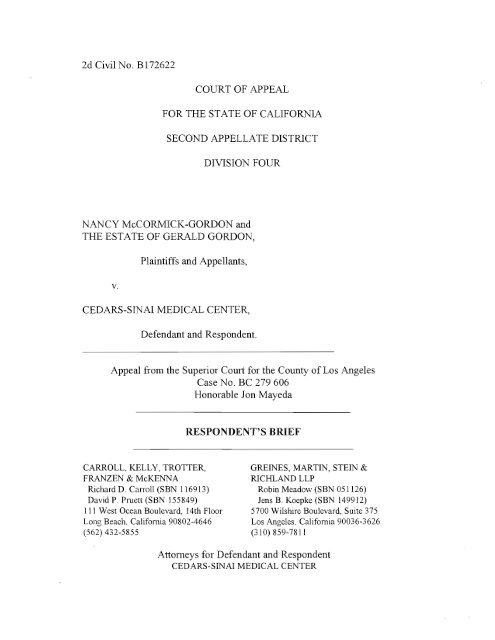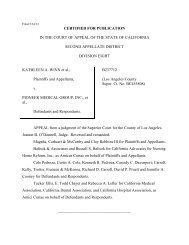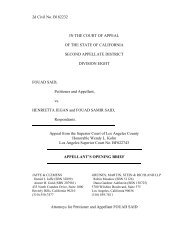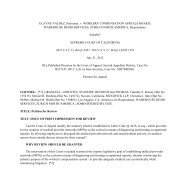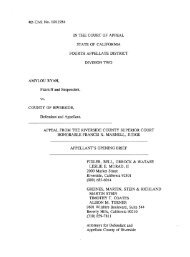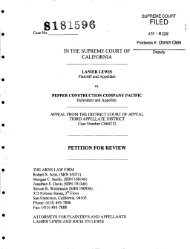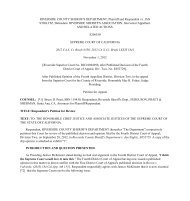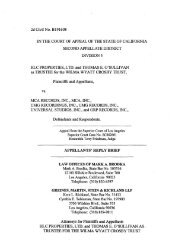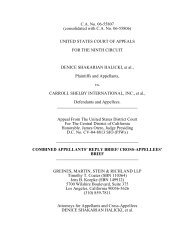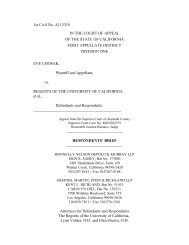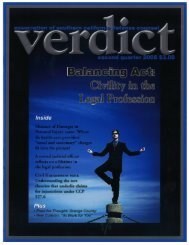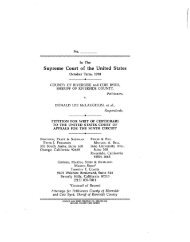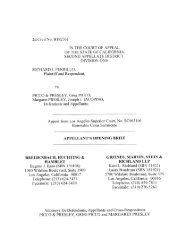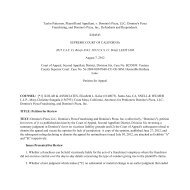McCormick-Gordon v. Cedars-Sinai Medical Center RB
McCormick-Gordon v. Cedars-Sinai Medical Center RB
McCormick-Gordon v. Cedars-Sinai Medical Center RB
Create successful ePaper yourself
Turn your PDF publications into a flip-book with our unique Google optimized e-Paper software.
2d Civil No. B172622<br />
COURT OF APPEAL<br />
FOR THE STATE OF CALIFORNIA<br />
SECOND APPELLATE DISTRICT<br />
DIVISION FOUR<br />
NANCY McCORMICK-GORDON and<br />
THE ESTATE OF GERALD GORDON,<br />
v.<br />
Plaintiffs and Appellants,<br />
CEDARS-SINAI MEDICAL CENTER,<br />
Defendant and Respondent.<br />
Appeal from the Superior Court for the County of Los Angeles<br />
Case No. BC 279 606<br />
Honorable Jon Mayeda<br />
RESPONDENT'S BRIEF<br />
CARROLL, KELLY, TROTTER,<br />
FRANZEN & McKENNA<br />
Richard D. Carroll (SBN 116913)<br />
David P. Pruett (SBN 155849)<br />
III West Ocean Boulevard, 14th Floor<br />
Long Beach. California 90802-4646<br />
(562) 432-5855<br />
GREINES, MARTIN, STEIN &<br />
RICHLAND LLP<br />
Robin Meadow (SBN 051126)<br />
lens B. Koepke (SBN 149912)<br />
5700 Wilshire Boulevard, Suite 375<br />
Los Angeles. California 90036-3626<br />
(310) 859-7811<br />
Attomeys for Defendant and Respondent<br />
CEDARS-SINAI MEDICAL CENTER
TABLE OF CONTENTS<br />
Page<br />
INTRODUCTION<br />
STATE:MENT OF FACTS<br />
1<br />
3<br />
A.<br />
B.<br />
<strong>Gordon</strong>'s History OfMultiple, Severe Health Problems<br />
Leading Up To His Death.<br />
Trial Court Proceedings.<br />
3<br />
4<br />
I.<br />
2.<br />
<strong>Cedars</strong>-<strong>Sinai</strong>'s summary judgment motion: The<br />
catheter fragment did not cause <strong>Gordon</strong>'s death and<br />
<strong>Cedars</strong>-<strong>Sinai</strong> did not breach the standard ofcare.<br />
Plaintiffs' opposition.<br />
4<br />
5<br />
a.<br />
b.<br />
Evidence regarding Dr. Rifkin's<br />
qualifications.<br />
Evidence regarding <strong>Cedars</strong>-<strong>Sinai</strong>'s liability.<br />
5<br />
6<br />
STANDARD OF REVIEW<br />
ARGU:MENT<br />
The trial court rules that Dr. Rifkin is not qualified<br />
and has no reasonable basis for his conclusions.<br />
7<br />
7<br />
10<br />
I. THE TRIAL COURT DID NOT ABUSE ITS DISCRETION IN<br />
RULING THAT DR. RIFKIN WAS NOT QUALIFIED. 10<br />
A.<br />
B.<br />
Dr. Rifkin Had No Education, Training, Or Experience In<br />
Urology, Catheter Removal Or Infectious Diseases.<br />
Dr. Rifkin's General <strong>Medical</strong> Knowledge And Unrelated<br />
Work Experience Were Not Sufficient To Establish His<br />
Qualification To Opine On The Specialized Issues Present<br />
Here.<br />
11<br />
13<br />
1
TABLE OF CONTENTS (cont'd)<br />
II.<br />
THE TRIAL COURT DID NOT ABUSE ITS DISCRETION IN<br />
RULING THAT THERE WAS NO REASONABLE BASIS FOR<br />
DR. RIFKIN'S OPINIONS.<br />
Page<br />
16<br />
A<br />
B.<br />
c.<br />
Dr. Rifkin's Standard-Of-Care Conclusions Lacked Any<br />
Reasonable Basis.<br />
Dr. Rifkin Not Only Failed To Establish Any Basis For<br />
Causation, But His Opinions Actually Negated Causation.<br />
Dr. Rifkin's Causation Opinions Supplied No Reasonable<br />
Basis.<br />
16<br />
18<br />
20<br />
1. Recent California cases reject causation opinions<br />
like Dr. Rifkin's because they are unreasoned and<br />
unsupported. 22<br />
III.<br />
PLAINTIFFS CANNOT REMEDY THEIR FAlLURE OF<br />
PROOF BY RESORTING TO THE COJ\1MON KNOWLEDGE<br />
EXCEPTION OR RES IPSA LOQUITUR. 25<br />
A<br />
B.<br />
The Proper Standard OfCare For Removing Catheters Is<br />
Not Commonly Understood By Most Laypersons.<br />
Res Ipsa Loquitur Does Not Apply.<br />
26<br />
27<br />
1.<br />
2.<br />
CONCLUSION<br />
Plaintiffs failed to show that the catheter<br />
fragmentation probably occurred because of some<br />
negligence by <strong>Cedars</strong>-<strong>Sinai</strong>.<br />
<strong>Gordon</strong> failed to show that <strong>Cedars</strong>-<strong>Sinai</strong> was<br />
exclusively responsible for the catheter fragment.<br />
28<br />
30<br />
32<br />
..<br />
11
TABLE OF AUTHORITIES<br />
Page<br />
Cases<br />
Ann M v. Pacific Plaza Shopping <strong>Center</strong><br />
(1993) 6 Cal.4th 666<br />
Aguilar v. Atlantic Richfield Co.<br />
(2001) 25 Cal.4th 826<br />
Bardessono v. Michels<br />
(1970) 3 Ca1.3d 780<br />
Bennett v. Los Angeles Tumor Institute<br />
(1951) 102 Cal.App.Zd 293<br />
Branco v. Kearny Mota Park, Inc.<br />
(1995) 37 Cal.AppAth 184<br />
Bromme v. Pavitt<br />
(1992) 5 Cal.AppAth 1487<br />
Brown v. Poway Unified School Dist.<br />
(1993) 4 Ca1.4th 820<br />
Campbell v. Arco Marine, Inc.<br />
(1996) 42 Cal.AppAth 1850<br />
Chadock v. Cohn<br />
(1979) 96 Cal.App.3d 205<br />
Curtis v. Santa Clara Valley <strong>Medical</strong> <strong>Center</strong><br />
(2003) 110 Cal.AppAth 796<br />
Davey v. Southern Pacific Co.<br />
(1897) 116 Cal. 325<br />
Duarte v. Zachariah<br />
(1994) 22 Cal.AppAth 1652<br />
Dumas v. Cooney<br />
(1991) 235 Cal.App.3d 1593<br />
7<br />
7<br />
27<br />
14<br />
8<br />
1,10,19<br />
29<br />
8<br />
15<br />
26<br />
9<br />
19<br />
19<br />
111
TABLE OF AUTHORITIES<br />
Page<br />
Cases (cont' d)<br />
Elcome v. Chin<br />
(2003) 110 Cal.AppAth 310<br />
Folk v. Kilk<br />
(1979) 53 Cal.App.3d 176<br />
Gannon v. Elliot<br />
(1993) 19 Cal.AppAth 1<br />
Gicking v. Kimberlin<br />
(1985) 170 Cal.App.3d 73<br />
Huffman v. Lindquist<br />
(1951) 37 Ca1.2d 465<br />
In Re Lockheed Litigation Cases<br />
(2004) 115 Cal.AppAth 558<br />
In re Marriage ofBurgess<br />
(1996) 13 Ca1.4th 25<br />
Jackson v. Deft, Inc.<br />
(1990) 223 Cal.App.3d 1305<br />
Jambazian v. Borden<br />
(1994) 25 Cal.AppAth 836;<br />
Jennings v. Palomar Pomerado Health Systems, Inc.<br />
(2003) 114 Cal.AppAth 1108<br />
Kelley v. 'hunk<br />
(1998) 66 Cal.AppAth 519<br />
Korsak v. Atlas Hotels, Inc.<br />
(1992) 2 Cal.AppAth 1516<br />
10,29<br />
27-28,30<br />
30<br />
29<br />
14, 27<br />
8,23,24,31<br />
9<br />
8<br />
10<br />
8, 18,22,23<br />
18<br />
8<br />
IV
TABLE OF AUTHORITIES<br />
Page<br />
Cases (cont' d)<br />
LaPorte v. Houston<br />
(1948) 33 Ca1.2d 167<br />
Mann v. Cracchiolo<br />
(1985) 38 Ca1.3d 18<br />
Moore v. Belt<br />
(1949) 34 Ca1.2d 525<br />
Newing v. Cheatham<br />
(1975) 15 Ca1.3d 351<br />
29<br />
15<br />
11, 13<br />
28<br />
Ochoa v. Pacific Gas & Electric Co.<br />
(1998) 61 Cal.AppAth 1480<br />
Pearce v. Linde<br />
(1952) 113 Cal.App.2d 627<br />
Philip Chang & Sons Associates v. La Casa Novato<br />
(1986) 177 Cal.App.3d 159<br />
Piscitelli v. Friedenberg<br />
(2001) 87 Cal.AppAth 953<br />
Sanchez v. Rodriguez<br />
(1964) 226 Cal.App.2d 439<br />
Sinz v. Owens<br />
(1949) 33 Ca1.2d 749<br />
Siverson v. Weber<br />
(1962) 57 Ca1.2d 834<br />
Suidan v. County ofSan Diego<br />
(1999) 72 Cal.AppAth 916<br />
Transamerica Ins. Co. v. Tab Transportation, Inc.<br />
(1995) 12 Ca1.4th 389<br />
24<br />
13, 14<br />
9<br />
8<br />
27<br />
10<br />
28<br />
8<br />
9<br />
v
TABLE OF AUTHORITIES<br />
Page<br />
Cases (cont'd)<br />
Western Mutual Ins. Co. v. Yamamoto<br />
(1994) 29 Cal.AppAth 1474<br />
9<br />
Statutes<br />
Evidence Code section 720<br />
11<br />
VI
INTRODUCTION<br />
Gerald <strong>Gordon</strong> was a very sick man with multiple life-threatening<br />
health conditions. According to plaintiffs' own expert, he had only a 50%<br />
chance of surviving his 1999 lung transplant.<br />
Yet plaintiffs claim that he<br />
died because <strong>Cedars</strong>-<strong>Sinai</strong> <strong>Medical</strong> <strong>Center</strong> supposedly left a "small and<br />
uncomplicated" fragment of a urethral catheter in his body.<br />
Ap311 from its many other problems, plaintiffs' case fails because<br />
their own expert's declaration conclusively established lack of causation.<br />
The expert, Dr. Rifkin, stated that "[a]pproximately 50% oflung<br />
transplantation patients die in the first five years after transplantation."<br />
(CT 99: 16-17.) Since medical malpractice liability requires proof of<br />
causation to a "reasonable medical probability," the 50% chance of death<br />
following a lung transplant negates causation-it cannot be "more likely<br />
than not" that the catheter fragment caused his death. (Bromme v. Pavitt<br />
(1992) 5 Cal.App.4th 1487, 1498.)<br />
And plaintiffs' case does have other problems. The trial court<br />
correctly granted summary judgment, because not only was Dr. Rifkin<br />
unqualified to testify, but his opinions lacked any reasonable basis to show<br />
a breach of the standard of care or causation.<br />
Lack Of Qualifications. Dr. Rifkin had no specialized education or<br />
training in urology, catheter removal or infectious diseases-the topics<br />
about which he opined. Nor did he have any experience with catheters or<br />
treatment of infectious diseases. And neither his basic medical school
education, nor his recent work in a hair restoration practice and as a<br />
surgeon, qualified him.<br />
No Reasonable Basis For Opinions. As to standard of care,<br />
Dr. Rifkin said that <strong>Cedars</strong>-<strong>Sinai</strong> should have conducted an examination of<br />
the catheter upon removal, but he did not describe when and how such an<br />
examination should be done. The lack of any specificity should not be<br />
surprising since there is no evidence that he has ever removed (or even<br />
watched the removal of) a urethral catheter.<br />
Dr. Rifkin's causation opinions were even skimpier. He did not even<br />
attempt to refute the evidence of <strong>Cedars</strong>-<strong>Sinai</strong>'s expert that catheters are<br />
designed to remain in the body at length without harming the patient. Nor<br />
did he try to explain why it was that an inert catheter fragment, rather than<br />
multiple, deadly health conditions, "played a major role" in <strong>Gordon</strong>'s death.<br />
In fact that conclusion was contradicted by his own testimony that it was at<br />
least equally probable that <strong>Gordon</strong>'s lung transplant killed him.<br />
Res Ipsa Loquitur/Common Knowledge. Plaintiffs only seek to<br />
use these doctrines to establish a breach ofthe standard of care. If either<br />
Dr. Rifkin is unqualified or his causation opinions lack any reasonable<br />
basis, the COUl1 does not need to reach this argument-the case fails on<br />
causation. And contrary to plaintiffs' argument, this situation does not fall<br />
into the line of foreign body cases. Unlike scalpels or surgical instruments,<br />
catheters are supposed to remain in the body.<br />
The judgment must be affirmed.<br />
2
STATEMENT OF FACTS<br />
A. <strong>Gordon</strong>'s History Of Multiple, Severe Health Problems<br />
Leading Up To His Death.<br />
<strong>Gordon</strong> was in extremely poor health during the last years ofhis life.<br />
(CT 67:17-18.) He underwent a lung transplant in June 1999, which his<br />
body rejected. (CT 67: 10 & 19; 98: 1.) This resulted in severe immune<br />
suppression that, among other things, precipitated an outbreak of urethral<br />
warts. (CT 67: 10-12; 98:4-7.)<br />
Because the warts caused intractable<br />
bleeding and lesions in the urethral tissue, they had to be surgically<br />
removed, which required installation of an indwelling urethral catheter and<br />
suprapubic tube. (CT 67:2-3 & 12-14.) Besides the urethral surgery,<br />
<strong>Gordon</strong> had various other surgical procedures, including a hip replacement<br />
and cataract removal. (CT 67:1-2.) Because of these many surgeries and<br />
his overall ill health, <strong>Gordon</strong> had numerous urethral catheters placed during<br />
his hospital stays at <strong>Cedars</strong>-<strong>Sinai</strong> and at several other facilities. (CT 67:21<br />
22.)<br />
<strong>Gordon</strong> suffered from many other diseases and disorders. He had<br />
suffered a heart attack and was diagnosed with severe and chronic lung<br />
disease, severe osteoporosis, and chronic anemia. (CT 67:4-7.) His body<br />
was saddled with chronic inflammation and riddled with drug-resistant<br />
infections, both viral and bacterial, that affected his lungs, windpipe,<br />
intestines and nasal passages. (CT 67:7-9 & 18-20; 98:3-7.)<br />
Most likely during the periodic removal and replacement of one of<br />
his catheters, a "small and uncomplicated" fragment of the catheter was left<br />
3
in his body. (CT 67:22-25; 68:8.) <strong>Gordon</strong> claimed that <strong>Cedars</strong>-<strong>Sinai</strong> left<br />
the catheter fragment. (CT 16:22-26.) <strong>Cedars</strong>-<strong>Sinai</strong> did not admit that it<br />
left the catheter fragment, but it did remove the fragment immediately upon<br />
discovering it in late Aptil2001. (CT 59-60; 67:22-25; 68:5-8.) <strong>Gordon</strong><br />
died in August 2001 at the age of67. (CT 97:26; 66:28.)<br />
B. Trial Court Proceedings.<br />
<strong>Gordon</strong>'s wife and estate (plaintiffs) sued <strong>Cedars</strong>-<strong>Sinai</strong> and one of<br />
its doctors for medical malpractice. (CT 15-23.) After plaintiffs dismissed<br />
the individual doctor, <strong>Cedars</strong>-<strong>Sinai</strong> moved for summary judgment. (CT 2;<br />
31-53.)<br />
1. <strong>Cedars</strong>-<strong>Sinai</strong>'s summary judgment motion: The<br />
catheter fragment did not cause <strong>Gordon</strong>'s death and<br />
<strong>Cedars</strong>-<strong>Sinai</strong> did not breach the standard of care.<br />
<strong>Cedars</strong>-<strong>Sinai</strong> argued that even ifit was responsible for leaving the<br />
small catheter fragment in <strong>Gordon</strong>'s body, doing so would not constitute a<br />
breach of the standard of care and did not cause <strong>Gordon</strong>'s eventual death.<br />
(CT 31-53.) <strong>Cedars</strong>-<strong>Sinai</strong> supported its motion with a declaration from<br />
1. Bradley Taylor, M.D., a board-certified urologist with over 20 years<br />
experience in urology. (CT 66:3-12; 69-73.)<br />
Dr. Taylor declared that, to a reasonable degree ofmedical<br />
probability, the catheter fragment did not cause or contribute to <strong>Gordon</strong>'s<br />
death. (CT 68:2-4 & 10-13.) He explained that catheters moe biocompatible<br />
and intrinsically designed to remain inside the body for an extended<br />
4
period-their presence has no deleterious effect. (CT 67:28-68:2.) A small<br />
piece of a catheter left accidentally in a body would have no more effect<br />
than an entire catheter placed intentionally. (CT 67:26-28.) Dr. Taylor<br />
opined that <strong>Gordon</strong> most likely died ofrespiratory failure caused by<br />
pseudomonas infection. (CT 68: 10-11.) Dr. Taylor concluded that in<br />
placing the catheters and removing the fragment immediately upon its<br />
discovery, <strong>Cedars</strong> abided by the standard of care for urologists in the<br />
community. (CT 68:5-15.)<br />
2. Plaintiffs' opposition.<br />
a. Evidence regarding Dr. Rifkin's<br />
qualifications.<br />
The declaration of plaintiffs expert, Dr. Marc A. Rifkin, only<br />
supplied basic biographical data: He received his medical doctorate from<br />
the University of Guadalajara, he is board certified in general surgery, he is<br />
licensed in several states, and he has been an instructor or fellow in surgery<br />
at various institutions. (CT 97:2-24.) There was no evidence that<br />
Dr. Rifkin had ever received any training or specialized education in<br />
urology or infectious diseases, or that he had ever practiced in urology or<br />
infectious diseases. (CT 97-99.) Indeed, his practical experience only<br />
became evident when <strong>Cedars</strong>-<strong>Sinai</strong> submitted his resume in support of its<br />
evidentiary objections to his declaration. (CT Ill.) That resume revealed<br />
that Dr. Rifkin had worked in a hair restoration practice for the prior 12<br />
years.<br />
(CT 109, 111.) Before that, he spent a few years in private practice<br />
5
as a surgeon. (CT 111.) Again, there was no evidence that any ofhis<br />
professional experience involved urology, catheters or infectious diseases.<br />
b. Evidence regarding <strong>Cedars</strong>-<strong>Sinai</strong>'s liability.<br />
Dr. Rifkin assumed that the catheter fragment was left in <strong>Gordon</strong>'s<br />
body during a hospitalization at <strong>Cedars</strong>-<strong>Sinai</strong>, and opined that the fragment<br />
had been there for three to twelve months before its April 2001 discovery.<br />
(CT 98:8-14.) He posited that, although failing to properly remove a<br />
catheter is "not an uncommon event," failing to detect the catheter fragment<br />
in an immune-suppressed patient like <strong>Gordon</strong> was a breach of the standard<br />
of care because the broken catheter should have been noticed when it was<br />
removed. (CT 98: 15-16 & 98:26-99:5.)<br />
Dr. Rifkin acknowledged that <strong>Gordon</strong>'s medical history was "quite<br />
complex," that he had a "fairly complicated course after his transplant," and<br />
that "[a]pproximately 50% oflung transplantation patients die in the first<br />
five years after transplantation." (CT 97:28; 98:2-3; 99:16-17.)<br />
Nevertheless, he concluded that the catheter fragment "played a major role"<br />
in <strong>Gordon</strong>'s death.<br />
(CT 99: 19-21.) He did not explain how a catheter<br />
fragment created any more risk than an entire catheter, which he<br />
acknowledged <strong>Gordon</strong> had in his body throughout much of this time.<br />
(CT 99:6-21.)<br />
6
3. The trial court rules that Dr. Rifkin is not qualified<br />
and has no reasonable basis for his conclusions.<br />
. The trial court struck Dr. Rifkin's testimony. (<strong>Gordon</strong>'s Motion to<br />
Augment, Ex. A; <strong>Cedars</strong>-<strong>Sinai</strong>'s Motion to Augment, Ex. 2.) Plaintiffs<br />
incorrectly assume that the trial court's only substantive summary judgment<br />
order was a September 4, 2003 Minute Order that relied solely on<br />
Dr. Rifkin's lack of qualifications. (See AOB 5, fn. 1; <strong>Gordon</strong>'s Motion to<br />
Augment, Ex. A.) In fact, the court actually issued a formal order on<br />
October 1, 2003, in which it ruled that Dr. Rifkin "failed to state the basis<br />
of his opinion regarding the standard of care in the community." (CT 2;<br />
<strong>Cedars</strong>-<strong>Sinai</strong>'s Motion to Augment, Ex. 1.) Indeed, at the motion hearing<br />
the trial cOUl1 questioned Dr. Rifkin's declaration on both ofthese grounds.<br />
(<strong>Cedars</strong>-<strong>Sinai</strong>'s Motion to Augment, Ex. 2 [RT 1:17-24; 6:25-7:8].)<br />
Without an admissible expert declaration, plaintiffs had no evidence<br />
to counter <strong>Cedars</strong>-<strong>Sinai</strong>'s expert evidence. The trial cOUl1 therefore granted<br />
summary judgment. (CT 114.) Plaintiffs timely appealed. (CT 122.)<br />
STANDARD OF REVIEW<br />
Courts of appeal generally review summary judgments de novo.<br />
(Ann M. v. Pacific Plaza Shopping <strong>Center</strong> (1993) 6 Ca1.4th 666, 673-674.)<br />
However, "it is also true that any determination underlying any order is<br />
scrutinized under the test appropriate to such determination." (Aguilar v.<br />
Atlantic Richfield Co. (2001) 25 Ca1.4th 826,859.) The underlying<br />
determination of whether an expert is qualified or whether there is a<br />
7
easonable basis for his opinion is reviewed for abuse of discretion.<br />
(Jackson v. Deji, Inc. (1990) 223 Cal.App.3d 1305, 1319-1320<br />
[qualification]; Korsak v. Atlas Hotels, Inc. (1992) 2 Cal.App.4th 1516,<br />
1523 [basis for opinion]; accord, AOB 5 [qualification].) That standard<br />
requires plaintiffs to show that the trial court's expert testimony rulings<br />
"exceeded the bounds of reason." (Piscitelli v. Friedenberg (2001) 87<br />
Cal.App.4th 953, 972.)<br />
Division Three of this Court very recently applied these principles in<br />
a procedurally identical context. In In re Lockheed Litigation Cases (2004)<br />
115 Cal.App.4th 558, the trial court had granted summary judgment after<br />
determining that the plaintiffs expert evidence was inadmissible. The court<br />
of appeal held that the admissibility ruling must be reviewed for an abuse of<br />
discretion, even if the overall summary judgment should be scrutinized<br />
under independent review. (1d. at pp. 563-564.Y<br />
Plaintiffs maintain that de novo review governs here, but the cases<br />
they cite all involved summary judgments where there was no underlying<br />
ruling with a different review standard. (See AOB 4, 7, citing Branco v.<br />
Kearny Mota Park, Inc. (1995) 37 Cal.App.4th 184, 189; Campbell v. Arco<br />
Marine, Inc. (1996) 42 Cal.App.4th 1850, 1855; and Suidan v. County of<br />
San Diego (1999) 72 Cal.App.4th 916, 920.)<br />
I Although Jennings v. Palomar Pomerado Health Systems, Inc. (2003)<br />
114 Cal.App.4th 1108 suggests a somewhat more deferential standard of<br />
review of expert medical testimony in a jury trial case, the court<br />
nevertheless upheld the striking oftestimony far more detailed than<br />
Dr. Rifkin's from an expert who was concededly qualified. (1d. at p. 1118,<br />
fn.9.)<br />
8
Accordingly, the Court must first decide whether the trial COUlt<br />
abused its discretion in determining that Dr. Rifkin's opinions were<br />
inadmissible. The COUlt must then analyze the summary judgment on the<br />
basis of whatever evidence remains.<br />
Although the record reveals that the trial court issued multiple orders<br />
reflecting different grounds for granting summary judgment, it is immaterial<br />
what grounds the trial COUlt actually relied upon, because a reviewing COUlt<br />
"must affirm so long as any ofthe grounds urged by [the moving patty],<br />
either here or in the trial court, entitles it to summary judgment." (Western<br />
Mutual Ins. Co. v. Yamamoto (1994) 29 Cal.App.4th 1474, 1481~<br />
Transamerica Ins. Co. v. Tab Transportation, Inc. (1995) 12 Cal.4th 389,<br />
399, fn. 4 ["[A] ruling or decision, itself correct in law, will not be<br />
disturbed on appeal merely because given for a wrong reason. Ifright upon<br />
any theory of the law applicable to the case, it must be sustained regardless<br />
of the considerations which may have moved the trial COUlt to its<br />
conclusion"], quoting Davey v. Southern Pacific Co. (1897) 116 Cal. 325,<br />
329.) This principle applies with equal force to the situation hereevidentiary<br />
rulings govemed by the abuse-of-discretion standard. (In re<br />
Marriage ofBurgess (1996) 13 Cal.4th 25, 32 [discretionary custody ruling<br />
affirmed if correct on any ground]; Philip Chang & Sons Associates v. La<br />
Casa Novato (1986) 177 Cal.App.3d 159, 173 [exclusion of evidence<br />
affirmed even if objection granted was incorrect because correct objection<br />
existed].)<br />
9
ARGUMENT<br />
I.<br />
THE TRIAL COURT DID NOT ABUSE ITS<br />
DISCRETION IN RULING THAT DR. RIFKIN WAS<br />
NOT QUALIFIED.<br />
c c<br />
[I]n any medical malpractice action, the plaintiffmust establish:<br />
'( I) the duty of the professional to use such skill, prudence, and diligence<br />
as other members of his profession commonly possess and exercise;<br />
(2) a breach of that duty; (3) a proximate causal connection between the<br />
negligent conduct and the resulting injury; and (4) actual loss or damage<br />
resulting from the professional's negligence. '" (Elcome v. Chin (2003) 110<br />
Ca1.App.4th 310, 317, citations omitted.)<br />
Califomia law has long been settled that expert testimony is<br />
ordinarily necessary to establish both a breach ofthe standard of care and<br />
causation. (Sinz v. Owens (1949) 33 Ca1.2d 749,753 [standard of care];<br />
Jambazian v. Borden (1994) 25 Cal.App.4th 836,844 [standard of care];<br />
Bromme v. Pavitt, supra, 5 Cal.App.4th at p. 1498 [causation].) In certain<br />
limited situations, the doctrine of res ipsa loquitur can substitute for expert<br />
testimony.<br />
But, as we will show, plaintiffs neither provided sufficient,<br />
qualified expert testimony nor established a basis for applying res ipsa.<br />
10
A. Dr. Rifkin Had No Education, Training, Or Experience In<br />
Urology, Catheter Removal Or Infectious Diseases.<br />
"A person is qualified to testify as an expert ifhe has special<br />
knowledge, skill, experience, training, or education sufficient to qualify him<br />
as an expert on the subject to which his testimony relates." (Evid. Code,<br />
§ 720; Moore v. Belt (1949) 34 Ca1.2d 525, 532.)<br />
Dr. Rifkin had no specialized training or board certification in<br />
urology or infectious diseases. His only board certification was in general<br />
surgery. (CT 97:20-22.) So aside from whatever he may have learned at<br />
the University of Guadalaja, he had no education or specialized training in<br />
urological conditions, appropriate use of catheters, standards concerning<br />
placement and removal of catheters, or infectious diseases.<br />
Dr. Rifkin's work experience also diverged far from the fields of<br />
urology and infectious diseases. At the time ofhis declaration, he had been<br />
working in a hair restoration practice for the previous 12 years. (CT 109,<br />
111.) Before that, Dr. Rifkin spent a few years in private practice as a<br />
surgeon. (CT 111.) Plaintiffs presented no evidence that Dr. Rifkin had<br />
ever placed any catheters or done any urological examinations. There was<br />
also no evidence that any of Dr. Rifkin's work experience involved<br />
diagnosing or treating infectious diseases. Given this lack of relevant work<br />
experience, it is Hot surprising that plaintiffs didn't even bother to submit<br />
Dr. Rifkin's curriculum vitae, but instead relied solely on a generic, oneparagraph<br />
summary of his educational background. (CT 97:7-24.)<br />
11
In the trial court, plaintiffs presented Dr. Rifkin as qualified because<br />
he received a medical doctorate from the University of Guadalajara, was<br />
admitted to practice in various states, and was a board-certified instructor<br />
and fellow in general surgery. (CT 97:7-24.) But a general medical<br />
education and some specialized training in surgery does not qualify one to<br />
opine about urology or infectious diseases. Apparently recognizing this<br />
problem, in their opening briefplaintiffs augment Dr. Rifkin's<br />
qualifications by drawing from his resume-which <strong>Cedars</strong>-<strong>Sinai</strong>, not<br />
plaintiffs, put into evidence-to show that Dr. Rifkin had other experience.<br />
(AOB 7.) This experience does not catapult Dr. Rifkin over the<br />
qualification hurdle, because it has nothing to do with urology, catheters or<br />
infectious diseases.<br />
Indeed, plaintiffs acknowledge that the scope of Dr. Rifkin's<br />
qualifications are limited "to provid[ing] an opinion on medical treatments<br />
related to surgery or trauma." (AOB 7.) Yet Dr. Rifkin's opinions did not<br />
relate to surgical procedures or trauma, but rather to catheter removal and<br />
bacterial infections. As we will show, the limitation plaintiffs now place on<br />
the scope ofDr. Rifkin's qualifications is fatal to their argument.<br />
12
B. Dr. Rifkin's General <strong>Medical</strong> Knowledge And Unrelated<br />
Work Experience Were Not Sufficient To Establish His<br />
Qualification To Opine On The Specialized Issues Present<br />
Here.<br />
General medical knowledge is not enough when the issue involved is<br />
specialized. For example, in Moore v. Belt, supra, 34 Ca1.2d 525, the<br />
plaintiff sued for medical malpractice over an infection that followed a<br />
urological examination, but lost at trial after the trial court found his expert<br />
not qualified. (ld. at pp. 527 & 531.) Although the plaintiffs expert had<br />
been an autopsy surgeon for over 29 years and was educated about the<br />
anatomy and infections in the genital-urinary system, our Supreme Court<br />
found he was not qualified to testify on the standards related to urological<br />
exams. (Id. at pp. 531-532.) The Court emphasized that the expert was not<br />
a urologist, had never done urological examinations and was not familiar<br />
with the current standards of practice in urology. (Ibid.) Dr. Rifkin<br />
similarly exhibited no experience or familiarity with the current practice<br />
standards in urology. Indeed, spending the last 12 years in a hair<br />
restoration practice negates any such experience or familiarity. (CT 109,<br />
111.)<br />
An expert's lack of directly relevant education and training likewise<br />
doomed his ability to testify in Pearce v. Linde (1952) 113 Cal.App.2d 627.<br />
There, an intemist who had read about foot surgeries opined on an<br />
orthopedic surgeon's negligence in performing foot surgery. (ld. at p. 629.)<br />
The court upheld the expert's disqualification, ruling that "the testimony of<br />
13
an expert in internal medicine would be no more persuasive than that of a<br />
layman who had read and heard what was the proper professional practice."<br />
(ld. at p. 630.) Dr. Rifkin's general medical school education and board<br />
certification in general surgery made him no more suitable to testify than<br />
reading about another specialty, which the Court rejected in Pearce. (See<br />
also Huffman v. Lindquist (1951) 37 Ca1.2d 465,476-479 [longtime county<br />
coroner, medical examiner, experienced pathologist and autopsyist not<br />
qualified to testify about treatment ofbrain injuries].)<br />
Even if Dr. Rifkin's education sufficed, his lack of experience with<br />
urological conditions, catheters or infectious diseases rendered him<br />
unqualified. In Bennett v. Los Angeles Tumor Institute (1951) 102<br />
Cal.App.2d 293, the plaintiff had received bums from X-ray treatment for<br />
papillomae on the soles of her feet. (ld. at p. 295.) The plaintiffrelied on<br />
testimony from a chiropodist who was licensed to treat foot conditions and<br />
use X-ray treatment and who had studied dermatological foot conditions<br />
and X-rays, but who had never actually used X-ray treatment. (ld. at<br />
p. 297.) In upholding his disqualification, the COUl1 of Appeal focused on<br />
the fact he had never been trained in or actually used X-ray treatment.<br />
(Ibid.) Similarly, although Dr. Rifkin's medical license may have permitted<br />
him to conduct urological examinations and to place and remove catheters,<br />
there is no evidence he has ever actually done so. Indeed, Dr. Rifkin was<br />
less qualified than the expert in Bennett, since he had never even received<br />
any training or education in urology. Thus, plaintiffs were right when they<br />
limited the scope ofhis qualifications to "medical treatments related to<br />
14
surgery or trauma" (AGB 7)-outside ofthis arena, Dr. Rifkin was<br />
unqualified.<br />
Mann v. Cracchiolo (1985) 38 Ca1.3d 18 (cited at AGB 5) does not<br />
require a different result.<br />
There the plaintiffs decedent, while receiving<br />
foot X-rays in preparation for surgery, fell and broke her neck and<br />
eventually died. (ld. at p. 31.) The plaintiff proffered an expert<br />
neurosurgeon who opined that the defendants, particularly the radiologists,<br />
failed to discover the neck fracture and order the correct X-rays after her<br />
fall. (ld. at pp. 34-35.) The trial court found the expert not qualified, but<br />
the Supreme COUl1 reversed. It noted that since the expert "regularly read<br />
X-rays and radiologists' reports," he was familiar with the standard of care<br />
for reading those reports. (ld. at p. 38.) Dr. Rifkin's experience was not<br />
remotely comparable. The expert in Mann learned from practical<br />
experience what he lacked in formal education or training. But Dr. Rifkin<br />
had nothing to offer-no urology or infectious disease education, no<br />
training, and no practical experience.<br />
Chadock v. Cohn (1979) 96 Cal.App.3d 205, the only other decision<br />
plaintiffs cite on this subject (AGB 7), is no closer to the mark. There, the<br />
plaintiff sued a doctor for negligently perforrning foot surgery, The<br />
plaintiff lost when the trial court found that her expert was not qualified<br />
because he was a podiatrist, not a physician. (96 Cal.App.3d at p. 207.)<br />
The cOUl1 of appeal reversed, ruling that the podiatrist had specialized<br />
education about foot injuries, had performed many foot surgeries including<br />
the particular procedure at issue, and was familiar with the standard of care<br />
for foot surgery.<br />
(ld. at pp. 209-215.) Again, Dr. Rifkin had none of those<br />
15
qualifications-no specialized education, no experience or training with<br />
catheters, and no familiarity with urological or infectious disease standards.<br />
Given the admittedly limited scope of Dr. Rifkin's qualifications, the<br />
unrelated education and the dearth of experience, plaintiffs cannot show<br />
that the trial court abused its discretion in refusing to find him qualified.<br />
H.<br />
THE TRIAL COURT DID NOT ABUSE ITS<br />
DISCRETION IN RULING THAT THERE WAS NO<br />
REASONABLE BASIS FOR DR. RIFKIN'S OPINIONS.<br />
A. Dr. Rifkin's Standard-Of-Care Conclusions Lacked Any<br />
Reasonable Basis.<br />
The sum total of Dr. Rifkin's testimony on the standard of care was:<br />
"When one removes a catheter, one looks at it to determine whether or not<br />
it is intact. If a piece is missing, it is clear that something is wrong. Failure<br />
to detect the broken catheter and take corrective action in this<br />
immunosuppressed patient falls below the standard of care in the<br />
community." (CT 98:27-99:5.) Dr. Rifkin provided none of the necessary<br />
factual foundation and no reasonable explanations for these conclusions.<br />
No Familiarity With Urology Standard Of Care. Dr. Rifkin<br />
presented no evidence that he was familiar with the standard of care for<br />
urologists in Southern California or for the removal of catheters. Indeed,<br />
there was no evidence that Dr. Rifkin has ever removed a catheter or even<br />
16
watched one being removed. Without any established familiarity with the<br />
standard of care, his conclusions about how <strong>Cedars</strong>-<strong>Sinai</strong> allegedly<br />
breached it lack any reasonable basis.<br />
No Precise Description Of The Allegedly Required Examination<br />
OfA Removed Catheter. Dr. Rifkin did not explain how a urologist or<br />
nurse is supposed to conduct an examination of the removed catheter. Is it<br />
done visually, tactilely, under a microscope, or by a laboratory? Dr. Rifkin<br />
stated that improperly removing a catheter is "not an uncommon event."<br />
(CT 98:16.)<br />
Surely ifthis is not an uncommon event, there must be an<br />
established procedure for detecting fragments-a standard of care. But<br />
then again, Dr. Rifkin also did not quantify "uncommon" or explain why<br />
(according to him) catheters are commonly removed improperly. Nor did<br />
he demonstrate how he came by this supposed knowledge without ever<br />
having had any experience in placing or removing catheters or even reading<br />
about doing so. Yet another gap in Dr. Rifkin's reasoning is that while he<br />
implicitly equated improper removal with breakage, he gave no reasons.<br />
No Explanation OfWhen Such "Examination" Is Necessary. The<br />
fragment discovered in <strong>Gordon</strong>'s bladder was "small and uncomplicated."<br />
(CT 68:8.) Do the need and scope ofDr. Rifkin's amorphous<br />
"examination" depend on the size ofthe fragment? If so, is the failure to<br />
look for breakage a breach of the standard of care when the fragment is<br />
small? Dr. Rifkin's declaration gave no clues to answer these important<br />
questions.<br />
17
"[A]n expert opinion is worth no more than the reasons upon which<br />
it rests." (Kelley v. Trunk (1998) 66 Cal.App.4th 519, 524.) Thus, in<br />
Kelley the cOUl1 reversed a defense summary judgment because it was<br />
"based on a conclusory expert declaration which states the opinion that no<br />
malpractice has occurred, but does not explain the basis for the opinion."<br />
(ld. at p. 521.) The expert had only described a few background facts and<br />
then leapt to the conclusion that the defendant had acted within the standard<br />
of care. (ld. at p. 522.) Dr. Rifkin also provided practically no reasoning<br />
and no factual detail at all to support his conclusion that <strong>Cedars</strong>-<strong>Sinai</strong><br />
breached the standard of care.<br />
B. Dr. Rifkin Not Only Failed To Establish Any Basis For<br />
Causation, But His Opinions Actually Negated Causation.<br />
Even if Dr. Rifkin's declaration crossed the threshold for showing a<br />
breach of the standard of care, it fell woefully short in its attempt to show<br />
causation. One shortfall is that Dr. Rifkin's causation opinions established<br />
no reasonable medical probability that the fragment caused <strong>Gordon</strong>'s death.<br />
Quite the opposite: His opinion negates that result.<br />
The linchpin of causation in medical malpractice case is reasonable<br />
medical probability. (Jennings v. Palomar Pomerado Health Systems, Inc.,<br />
supra, 114 Cal.App.4th at p. 1117.) Jennings explained the "distinction<br />
between a reasonable medical 'probability' and a medical 'possibility? this<br />
way: "A possible cause only becomes 'probable' when, in the absence of<br />
other reasonable causal explanations, it becomes more likely than not that<br />
the injury was a result of its action." (ld., emphasis added and omitted.)<br />
18
Although Dr. Rifkin said that the catheter fragment played a "major<br />
role" in <strong>Gordon</strong>'s death (CT 99:20), elsewhere he made clear that, whatever<br />
"major role" means, it does not mean "reasonable medical probability."<br />
That is because, according to Dr. Rifkin, <strong>Gordon</strong> had only a 50% chance of<br />
surviving his lung transplant, irrespective of any other health conditions or<br />
catheter fragments,. (CT 99: 16-17.) This probability means that it cannot<br />
be "more likely than not" that the catheter fragment, rather than the lung<br />
transplant-to say nothing of all <strong>Gordon</strong>'s other ailments-was what<br />
caused <strong>Gordon</strong>'s death.<br />
The court in Bromme v. Pavitt, supra, 5 Cal.App.4th 1487 came to<br />
precisely the same conclusion: "California does not recognize a cause of<br />
action for wrongful death based on medical negligence where the decedent<br />
did not have a greater than 50 percent chance of survival had the defendant<br />
properly diagnosed and treated the condition." (ld at pp. 1504-1505.) In<br />
Bromme the plaintiff claimed that the defendant's failure to diagnose his<br />
wife's colon cancer caused her death. (ld at p. 1492.) But since the<br />
experts agreed that as of a certain date the wife only had a 50% chance of<br />
survival, the court found that as to any conduct after that date, the plaintiff<br />
failed the more-likely-than-not standard-thus he could not show causation<br />
to the required degree of a reasonable medical probability. (ld. at pp. 1499<br />
1504} According to Dr. Rifkin, <strong>Gordon</strong>'s situation was identical: Even if<br />
2 See also Duarte v. Zachariah (1994) 22 Cal.App.4th 1652, 1657-1658<br />
(overprescription of chemotherapy drug could not be cause of medical<br />
malpractice injury because there was, at best, only a 50% chance<br />
chemotherapy would avert reoccurrence ofthe cancer); Dumas v. Cooney<br />
(1991) 235 Cal.App.3d 1593,1603 (failure to diagnose plaintiffs lung<br />
(continued...)<br />
19
a catheter fragment had never been left in <strong>Gordon</strong>'s body, <strong>Gordon</strong>, like all<br />
"lung transplantation patients" and like the wife in Bromme. had only<br />
a 50% chance of survival. (CT 99:16-17.) Therefore, like Mr. Bromme,<br />
plaintiffs cannot establish causation.<br />
C. Dr. Rifkin's Causation Opinions Supplied No Reasonable<br />
Basis.<br />
Even if Dr. Rifkin's opinions established the requisite reasonable<br />
medical probability, they were still inadmissible because they contained no<br />
reasonable basis. Dr. Rifkin simply concluded that the presence ofthe<br />
catheter fragment made antibiotic treatment of <strong>Gordon</strong>'s urinary tract<br />
infection impossible and led to the emergence of pseudomonas blood<br />
poisoning that caused <strong>Gordon</strong>'s death. (CT 99:6-15.) He also cryptically<br />
opined that the fragment was a "potentially catastrophic problem in<br />
a patient who has been treated with immunosuppressant drugs." (CT 98: 17<br />
18.) But there are gaping and unexplained holes in his reasoning.<br />
<strong>Gordon</strong>'s Bad Health History. It is not clear whether Dr. Rifkin<br />
fully understood and accounted for the gravity of <strong>Gordon</strong>'s myriad health<br />
problems, since he only "reviewed selected medical records"-none of<br />
which he identified or described. (CT 97:25-26.) Dr. Rifkin did<br />
acknowledge that <strong>Gordon</strong>'s health condition had taken a "fairly<br />
complicated course" over the last few years, that he had been beset with<br />
2 ( •••continued)<br />
cancer two years earlier not a cause of death because causation cannot exist<br />
"in cases where the evidence indicates that there is less than a probability,<br />
i.e., a 50-50 possibility or a mere chance").<br />
20
multiple, chronic infections, and that 50% of lung transplant patients die in<br />
the first five years. (CT 98:2-7; 99:16-17.) Yet he nevertheless concluded<br />
that it was the catheter fragment-not <strong>Gordon</strong>'s rejection of the lung<br />
transplant, his multiple, longstanding infections, his heart attack, or the<br />
many other conditions that plagued <strong>Gordon</strong>-that "played a major role" and<br />
"was a substantial factor" in <strong>Gordon</strong>'s death. (CT 99: 19-21.)<br />
Dr. Rifkin's Incomplete Causation Chain. There are also many<br />
missing links in Dr. Rifkin's causation chain. He did not explain how the<br />
catheter fragment, rather than <strong>Gordon</strong>'s immune-suppressed status<br />
following his rejection of the lung transplant, could be responsible for the<br />
pseudonomas infection. Nor did he explain how the pseudonomas led to<br />
blood poisoning and how that led to <strong>Gordon</strong>'s death. Most critically,<br />
Dr. Rifkin did not explain why the catheter fragment posed more of a risk<br />
to <strong>Gordon</strong> than the complete catheters that <strong>Gordon</strong> concededly had in his<br />
body during this time. Indeed, Dr. Rifkin did not rebut or even respond to<br />
Dr. Taylor's testimony that catheters (whether entire or partial) are<br />
designed to remain in the body for extended periods, much less explain why<br />
a fragment should behave differently. Finally, he did not describe how<br />
"immunosuppressant drugs" could combine with a catheter fragment to<br />
create a "catastrophic problem."<br />
21
1. Recent California cases reject causation opinions<br />
like Dr. Rifkin's because they are unreasoned and<br />
unsupported.<br />
Two recent California decisions reject unreasoned and unsupported<br />
causation opinions like Dr. Rifkin's. In Jennings v. Palomar Pomerado<br />
Health Systems, Inc., supra, 114 Cal.App.4th 1108 the plaintiff suffered<br />
a subcutaneous abdominal infection following surgery, and his expert<br />
opined that the infection was caused by the defendants' having negligently<br />
left a retractor in his abdominal cavity after the surgery. (ld. at p. 1111.) It<br />
was undisputed that (1) postoperative wound infections (like this one) are<br />
common, (2) the site ofthis infection was separated from the peritoneal<br />
cavity in which the retractor was left by muscles, fascia and the peritoneal<br />
wall, and (3) there was no evidence ofinfection in the peritoneal cavity.<br />
(ld. at pp. 1112-1113.) Finally, it was accepted that the plaintiff had an<br />
increased risk ofinfection because ofhis age, weight and type of surgery.<br />
(ld. at p. 1113.)<br />
The plaintiffs expert opined that the retractor was contaminated as it<br />
was placed in the wound, that it remained contaminated through several<br />
irrigations of the wound during surgery, and that before the body encased<br />
the retractor with a protective covering, bacteria from the contaminated<br />
retractor migrated across the peritoneal wall and caused the infection.<br />
(ld. at pp. 1114-1115.) The trial court snuck the expert's opinion as<br />
speculative. (Jd. at p. 1111.) The court of appeal agreed, observing that<br />
there was no evidence supporting the assumed bacterial migration:<br />
22
"[W]hen an expert's opinion is purely conclusory because unaccompanied<br />
by a reasoned explanation connecting the factual predicates to the ultimate<br />
conclusion, that opinion has no evidentiary value." (Id. at p. 1116.)<br />
Dr. Rifkin's opinion suffers from similar deficiencies. He<br />
acknowledged (1) that catheter removal problems are not uncommon,<br />
(2) that <strong>Gordon</strong> suffered from many infections completely separate from<br />
whatever the catheter fragment might have caused, and (3) that <strong>Gordon</strong> had<br />
an increased risk ofinfections because ofhis immune-suppressed state.<br />
Nevertheless, Dr. Rifkin concluded that a small fragment of a catheterwhich<br />
is designed to remain in the body-played a "major role" in<br />
<strong>Gordon</strong>'s death. Since Dr. Rifkin provided no reasonable explanation to<br />
connect the catheter fragment to <strong>Gordon</strong>'s eventual death-to explain its<br />
supposed "major role"-his opinion "has no evidentiary value." (Ibid)<br />
The court in In re Lockheed Litigation Cases, supra, 115<br />
Cal.App.4th 558 excluded an expert's causation opinion on similar grounds.<br />
The cOUl1 affirmed summary judgment against the plaintiffs, who had sued<br />
for wrongful death allegedly caused by exposure to toxic chemicals<br />
manufactured by the defendants. (Id at p. 561.) The court explained how<br />
expert opinions should be evaluated:<br />
"'The value of opinion evidence rests not in the conclusion<br />
reached but in the factors considered and the reasoning<br />
employed. Where an expert bases his conclusion upon<br />
assumptions which are not supported by the record, upon<br />
matters which are not reasonably relied upon by other<br />
experts, or upon factors which are speculative, remote or<br />
23
conjectural, then his conclusion has no evidentiary value.'"<br />
(ld. at p. 563, citations omitted.)<br />
The court held that it was unreasonable for the plaintiffs' expert to rely<br />
solely on a study finding that painters exposed to the chemicals at issue<br />
were more likely to contract cancer, because the painters in the study were<br />
exposed to some 130 different chemicals. (Id. at pp. 564-565.) Likewise,<br />
even if the catheter fragment left in <strong>Gordon</strong>'s body made him more prone to<br />
infection, that fact would not establish that the fragment caused his death,<br />
since the panoply of deadly diseases and infections that afflicted <strong>Gordon</strong><br />
long before (and after) the catheter fragment were equally probable causes.<br />
The trial court did not abuse its discretion in excluding Dr. Rifkin's<br />
causation opinions.'<br />
3 The outcome should be the same even ifthe Court finds that<br />
Dr. Rifkin's opinions were admissible. In Ochoa v. Pacific Gas & Electric<br />
Co. (1998) 61 Cal.App.4th 1480 the court found that the plaintiffs expert's<br />
contradictory causation opinion was admissible, but that it still did not<br />
create a triable issue because it was "equivocal and speculative" and<br />
because "he has no expertise in the relevant subject matter." (Jd. at p.<br />
1485.) As shown above, Dr. Rifkin's opinion is equally unqualified and<br />
speculative.<br />
24
HI.<br />
PLAINTIFFS CANNOT REMEDY THEIR FAILURE<br />
OF PROOF BY RESORTING TO THE COMMON<br />
KNOWLEDGE EXCEPTION OR RES IPSA<br />
LOQUITUR.<br />
Plaintiffs contend that they can fill the holes in Dr. Rifkin's<br />
declaration by invoking the common knowledge exception or the doctrine<br />
of res ipsa loquitur. (AOB 9-10.) But while these can occasionally<br />
substitute for the usually-required expert testimony, this case doesn't<br />
present such an occasion.<br />
Indeed, plaintiffs acknowledge that, at best, they can use these<br />
doctrines only to establish a breach ofthe standard of care, not causation.<br />
(AOB 9 & 10.) This concession is unavoidable, since at most the doctrines<br />
could establish <strong>Cedars</strong>-<strong>Sinai</strong>'s responsibility for the catheter fragment's<br />
presence in <strong>Gordon</strong>'s body; only expert testimony could possibly link the<br />
fragment's presence to any medical condition, much less to <strong>Gordon</strong>'s death.<br />
And, as shown in the preceding section, plaintiffs did not present sufficient<br />
expert causation testimony because Dr. Rifkin's opinions lacked any<br />
reasonable basis. Thus, even if plaintiffs can use res ipsa loquitur or<br />
common knowledge to establish a breach of the standard of care, they still<br />
have not carried their burden of showing all the negligence elements, and<br />
the judgment should be affirmed.<br />
Plaintiffs' use of res ipsa/common knowledge to establish a breach<br />
of the standard of care requires a gross oversimplification. Their argument<br />
25
is that catheters shouldn't fragment in a patient's body and therefore<br />
<strong>Cedars</strong>-<strong>Sinai</strong> must have breached the standard of care. (AOB 10.) It's not<br />
quite that simple.<br />
A. The Proper Standard Of Care For Removing Catheters Is<br />
Not Commonly Understood By Most Laypersons.<br />
The common knowledge exception cannot apply here because the<br />
proper standard of care for placing or removing urethral catheters is not<br />
something that most laypersons understand. This lack of obviousness about<br />
the standard of care is evident because even Dr. Rifkin's expert testimony<br />
concerning a breach ofthe standard of care is vague. How then is a<br />
layperson supposed to have a clear understanding?<br />
The fact that something unexpected happens during a medical<br />
procedure does not mean it is common knowledge that there was<br />
negligence. As one court recently observed, "results that might be<br />
considered 'freakish' or 'improbable' may actually be known<br />
complications, or might be unavoidable given the circumstances. Thus,<br />
while a layperson might find it surprising to learn that blindness can result<br />
from an operation upon a patient's back even in the absence of negligence,<br />
that is exactly what defendants' expert testimony demonstrated." (Curtis v.<br />
Santa Clara Valley <strong>Medical</strong> <strong>Center</strong> (2003) 110 Cal.App.4th 796, 803.)<br />
Similarly, a layperson might find it surprising that breakage of catheters<br />
occurs commonly. (CT 98: 15-16.) But that was Dr. Rifkin's testimony<br />
here.<br />
26
Our Supreme Court long ago explained that "[t]he 'law has never<br />
held a physician or surgeon liable for every untoward result which may<br />
occur in medical practice. ,,, (Huffman v. Lindquist, supra, 37 Ca1.2d at<br />
p. 473 [nonsuit affirmed]; see also Sanchez v. Rodriguez (1964) 226<br />
Ca1.App.2d 439, 449 ["A doctor is not a warrantor of cures nor is he<br />
required to guarantee results and in the absence of a want ofreasonable<br />
care and skill will not be held responsible for untoward results"].)<br />
<strong>Cedars</strong>-<strong>Sinai</strong> likewise cannot be held as a guarantor.<br />
The case plaintiffs cite, Bardessono v. Michels (1970) 3 Ca1.3d 780<br />
(AOB 9), presents a much more obvious common knowledge situation. The<br />
defendant gave the plaintiff, who was otherwise healthy, several cortisone<br />
shots in his sore shoulder; soon after, the plaintiff suffered paralysis and<br />
nerve damage. (ld. at pp. 784-786.) It is easy for any layperson to<br />
conclude that an injection should not result in paralysis or nerve damage in<br />
a healthy person. It is not commonly understood whether, when and how<br />
urethral catheters fragment and whether the fragmenting ofa catheter or the<br />
failure to discover a fragment breaches the standard of care-particularly in<br />
an elderly patient who has had repeated catheterizations.<br />
B. Res Ipsa Loquitur Does Not Apply.<br />
For this doctrine to apply, "( 1) the accident must be of a kind which<br />
ordinarily does not occur in the absence of someone's negligence; (2) it<br />
must be caused by an agency or instrumentality within the exclusive control<br />
of the defendant; (3) it must not have been due to any voluntary action or<br />
contribution on the part of the plaintiff." (Folk v. Kilk (1975) 53<br />
27
Cal.App.3d 176, 184, internal quotation marks omitted.) Plaintiffs bear the<br />
burden of showing each of these elements. (Newing v. Cheatham (1975) 15<br />
Ca1.3d 351, 364.) They cannot do so.<br />
1. Plaintiffs failed to show that the catheter<br />
fragmentation probably occurred because of some<br />
negligence by <strong>Cedars</strong>-<strong>Sinai</strong>.<br />
To use res ipsa loquitur to establish a breach ofthe standard of care,<br />
plaintiffs had to show that the catheter fragmentation or the failure to<br />
discover the fragment was "of such a nature that it can be said, in the light<br />
ofpast experience, that it probably was the result ofnegligence by someone<br />
and that the defendant is probably the person who is responsible."<br />
(Siverson v. Weber (1962) 57 Ca1.2d 834, 836 [nonsuit affirmed after res<br />
ipsa instruction refused].) They cannot make that showing.<br />
Here, it is not evident that the fragmenting of a catheter is<br />
necessarily the result of someone's negligence. Indeed, according to<br />
Dr. Rifkin catheter breakage is not an uncommon event. (CT 98: 15-16.)<br />
And Dr. Taylor opined-without refutation by Dr. Rifkin-that urethral<br />
catheters are intrinsically designed to remain in the body, so a catheter<br />
fragment poses no special danger. (CT 67:26-68:4.) Therefore, even if<br />
28
<strong>Cedars</strong>-<strong>Sinai</strong> were responsible for leaving the catheter fragment in<br />
<strong>Gordon</strong>'s body, that fact would not establish that <strong>Cedars</strong>-<strong>Sinai</strong> was<br />
negligent. 4<br />
Plaintiffs' invocation of res ipsa loquitur's "classic example"-"the<br />
X-ray revealing a scalpel left in the patient's body following surgery"<br />
(AOB 10)-does not rescue them, because the situation here is quite<br />
different. A scalpel is not intended or designed to remain in the human<br />
body, but rather only to be used during surgery and then removed. A<br />
urethral catheter, and therefore a fragment of a catheter, is intended to<br />
remain in the body indefmitely. If the presence of a urethral catheter in<br />
someone's body caused blood poisoning and death, then the newspapers<br />
4 Although plaintiffs only seek to use res ipsa loquitur to establish a<br />
breach of the standard of care, causation issues still rear their heads-"res<br />
ipsa loquitur does not apply where it is equally probable an accident was<br />
caused by some fault for which defendant was not responsible." (Gicking<br />
v. Kimberlin (1985) 170 Cal.App.3d 73, 77; see also LaPorte v. Houston<br />
(1948) 33 Ca1.2d 167, 170 [res ipsa did not apply because it "was at least<br />
equally probable" that a mechanical defect, rather than the defendant's<br />
negligence, caused the accident].) Another way the courts have expressed<br />
it is that res ipsa cannot apply when "[n]one of the altemative explanations<br />
for plaintiffs injuries is inherently more probable than the others."<br />
(Elcome v. Chin, supra, 110 Cal.App.4th 310, 320 [after bladder surgery<br />
plaintiff had arm and back pain]; see also Brown v. Poway Unified School<br />
Dist. (1993) 4 Ca1.4th 820, 827 [res ipsa was inapplicable where repairman<br />
slipped and fell on a piece of lunch meat on the school building floor,<br />
because the possibility that a school employee dropped the meat is not<br />
"inherently more probable" than other explanations].) Here there are<br />
several "inherently more probable," or at least "equally probable"<br />
explanations for <strong>Gordon</strong>'s death-he had suffered a heart attack, his body<br />
had rejected a lung transplant, and he suffered from multiple, chronic<br />
infections, all of which pre-dated and were unrelated to the catheter<br />
fragment.<br />
29
would be reporting that scores of patients had been dying after having<br />
catheters placed.<br />
This is why plaintiffs' reliance on Gannon v. Elliot (1993)<br />
19 Cal.App.4th 1 (AOB 10) is misplaced. Gannon involved a "large<br />
foreign body"-the 3 em x 1 em rubber cap of a surgical instrument-that<br />
the surgeon left in the plaintiffs body during a hip replacement surgery.<br />
(ld. at p. 4.) The plaintiffs expert said that given the size ofthe cap, it<br />
should have been easy to feel or see in the surgical field. (Ibid.) The<br />
catheter fragment here, on the other hand, was "small and uncomplicated."<br />
(CT 68:8.) And the catheter fragment is not a traditional "foreign body"<br />
because it is designed to remain in the body, as opposed to surgical<br />
instrument caps that are not. Gannon also is different because there it was<br />
undisputed that the presence of the large cap caused the plaintiff to need<br />
another, more destructive hip surgery, (Gannon v. Elliot, supra, 19<br />
Cal.App.4th at p. 4.) Here, the connection between the catheter fragment<br />
and <strong>Gordon</strong>'s death is, at best, tenuous.<br />
2. <strong>Gordon</strong> failed to show that <strong>Cedars</strong>-<strong>Sinai</strong> was<br />
exclusively responsible for the catheter<br />
fragment.<br />
The second element ofres ipsa loquitur is that the plaintiffs injury<br />
must be caused by something within the defendant's exclusive control.<br />
(Folk v. Kilk, supra, 53 Cal.App.3d at p. 184.) Plaintiffs fail this test, too.<br />
Even assuming plaintiffs can show the catheter fragment caused<br />
<strong>Gordon</strong>'s death, they must also establish that <strong>Cedars</strong>-<strong>Sinai</strong> was exclusively<br />
30
esponsible for leaving the fragment in <strong>Gordon</strong>'s body. But their own<br />
expert's testimony negates their ability to do so. Dr. Rifkin offered no<br />
direct evidence that <strong>Cedars</strong>-<strong>Sinai</strong> left the fragment; instead, he stated that<br />
the fragment had been there between three months and a year before its<br />
April 2001 discovery. (CT 98: 10-14.) The sheer breadth of that time<br />
period illuminates how difficult it is to defmitively determine when this<br />
catheter fragmented and who was responsible.<br />
This is particularly true since Dr. Rifkin gave no explanation for how<br />
he calculated the three- to twelve-month period except to say that<br />
"problems"-not described-would have become evident well before the<br />
fragment was removed. (CT 98:10-14.) This is no explanation at all,<br />
among other reasons because it is undisputed that many "problems" had<br />
been evident throughout this time-<strong>Gordon</strong> was fighting multiple drugresistant<br />
infections, and his body was rejecting the lung transplant.<br />
(CT 67:7-9 & 18-20; 98:3-7.) And ifthe fragment purportedly posed<br />
a "catastrophic problem," how could those problems take twelve months to<br />
reveal themselves? (CT 98: 17.) Why couldn't the fragment have been in<br />
<strong>Gordon</strong>'s body for two, three or four years prior to its discovery?<br />
Dr. Rifkin gave no explanation. In fact, tracing any temporal connection<br />
between any "problems" and a particular catheter removal would be<br />
difficult since <strong>Gordon</strong> had many catheters placed and removed in several<br />
facilities over the last few years ofhis life. (CT 67:21-22.)<br />
'''The value of opinion evidence rests not in the conclusion reached<br />
but in the factors considered and the reasoning employed. '"<br />
(In re<br />
Lockheed Litigation Cases, supra, 115 Cal.AppAth at p. 563.) The absence<br />
31
of any explanation of "the factors [Dr. Rifkin] considered and the reasoning<br />
[he] employed" in reaching his three- to twelve-month estimate means that<br />
the estimate has no evidentiary value and must be rejected.<br />
Plaintiffs' only other evidence on this point is Ms. <strong>Gordon</strong>'s<br />
statement that <strong>Gordon</strong> had been hospitalized only at <strong>Cedars</strong>-<strong>Sinai</strong> since<br />
May 1999. (CT 100:12-14.)5 But since Dr. Rifkin's opinion was too vague<br />
and unsupported to be admissible, Ms. <strong>Gordon</strong>'s statement alone does not<br />
establish that <strong>Cedars</strong>-<strong>Sinai</strong> had exclusive control over the fragmenting<br />
catheter.<br />
Plaintiffs did not establish the requisites to use res ipsa loquitur as<br />
a substitute for showing that <strong>Cedars</strong>-<strong>Sinai</strong> breached the standard of care.<br />
CONCLUSION<br />
<strong>Gordon</strong>'s death surely was a tragedy for his family. But to blame<br />
<strong>Cedars</strong>-<strong>Sinai</strong> for that death because it might have left a small catheter<br />
fragment in his body defies both science and Califomia medical malpractice<br />
5 In the first line of their opening brief, plaintiffs embellish on<br />
Ms. <strong>Gordon</strong>'s statement and Dr. Rifkin's opinion, stating-with no record<br />
support whatever-that a <strong>Cedars</strong>-<strong>Sinai</strong> "nurse left the balloon tip of a<br />
catheter." (AGB 1; see also AGB 2.)<br />
32
law. Plaintiffs cannot avoid summary judgment by relying on an<br />
unqualified expert witness and his wholly unsupported and conclusory<br />
opinions, nor by relying on the ill-fitting doctrine ofres ipsa loquitur. The<br />
Court should affinn the summary judgment.<br />
Dated: September 27, 2004<br />
CARROLL, KELLY, TROTTER, FRANZEN & McKENNA<br />
Richard D. Carroll<br />
David P. Pruett<br />
GREINES, MART]J'\J, STEIN & RICHLAND LLP<br />
Robin Meadow<br />
Jens B. Koepke<br />
By----_-r- --r--r--_~------<br />
ilnsB. Ko#<br />
Attomeys for Defendant and Respondent CEDARS-SINAI<br />
MEDICAL CENTER<br />
33


